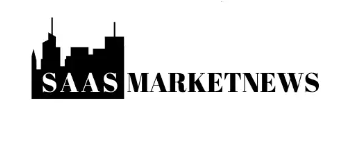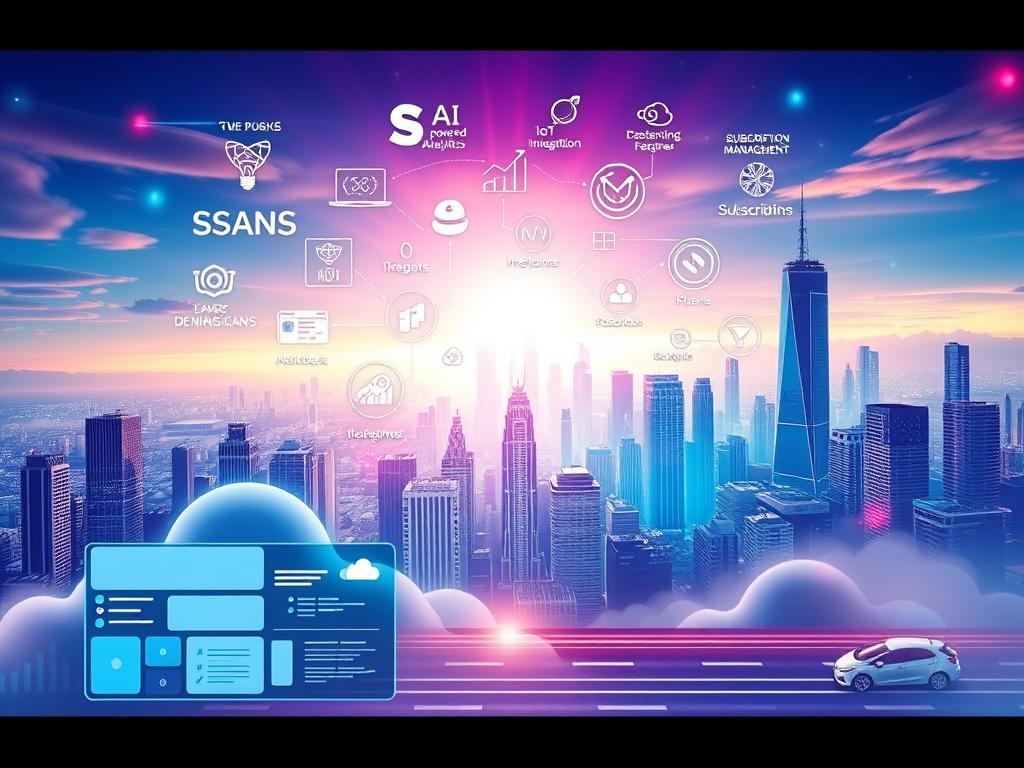top 10Trends in the SaaS Industry for 2025 The SaaS industry is on the cusp of significant evolution by 2025, driven by technological advancements and shifting business priorities.
As customer expectations continue to evolve, the industry is expected to undergo a major transformation. This article will explore the trends shaping the SaaS industry, providing insights into its future.
The latest SaaS trends indicate a shift towards more innovative and customer-centric solutions. Understanding these trends is crucial for businesses to stay ahead in the competitive landscape.
Key Takeaways
- The SaaS industry is expected to evolve significantly by 2025.
- Technological advancements are driving this evolution.
- Customer expectations are changing, influencing SaaS trends.
- Staying ahead of the competition requires understanding these trends.
- The future of the SaaS industry looks promising with innovative solutions.
The Current State of the SaaS Industry
top 10Trends in the SaaS Industry for 2025 The current landscape of the SaaS industry is characterized by robust growth and an increasing reliance on cloud technology. As businesses continue to migrate to cloud-based solutions, the demand for software as a service (SaaS) is on the rise.
Gartner predicts that worldwide spending on public cloud services will reach $723 billion in 2025, underscoring the significant expansion expected in the industry. The global SaaS market size is projected to grow at a compound annual growth rate (CAGR) of 13.7% through 2031, indicating a substantial increase in adoption across various sectors.
Market Size and Growth Projections
The SaaS market is experiencing rapid growth due to its scalability, flexibility, and cost-effectiveness. As noted by industry experts, “The shift towards cloud computing is driving the SaaS market’s upward trajectory.” This growth is further fueled by the increasing need for businesses to adapt to changing market conditions and consumer demands.
Key Players Shaping the Industry
Key players such as Salesforce, Microsoft, and Google are shaping the SaaS industry with their innovative solutions and strategic acquisitions. These companies are at the forefront of developing cutting-edge technologies that are transforming the way businesses operate.
As the SaaS industry continues to evolve, it’s essential for businesses to stay informed about the latest trends and market insights to remain competitive.
Top 10 Trends in the SaaS Industry to Watch
As we approach 2025, the SaaS industry is poised for significant transformations driven by emerging trends. The latest SaaS trends are not just about technological advancements; they’re also about how businesses can leverage these trends to stay competitive.
Business Impact of Staying Ahead
Staying ahead of the curve in the SaaS industry can have a substantial business impact. By adopting the latest trends, companies can improve their operational efficiency, enhance customer satisfaction, and drive revenue growth. For instance, integrating AI-powered solutions can help businesses automate tasks, gain deeper insights into customer behavior, and make data-driven decisions.
Competitive Advantages of Early Adoption
Early adoption of emerging SaaS trends can provide businesses with significant competitive advantages. Companies that are among the first to leverage new technologies and trends can differentiate themselves from their competitors, attract new customers, and establish themselves as industry leaders. The top 10 trends in the SaaS industry for 2025, including vertical SaaS, micro-SaaS, and enhanced security measures, offer numerous opportunities for businesses to gain a competitive edge.
By understanding and adopting these trends, businesses can position themselves for success in a rapidly evolving market. The key is to stay informed, be proactive, and be willing to adapt to changing market conditions.
Trend 1: Artificial Intelligence Integration
The integration of Artificial Intelligence (AI) is revolutionizing the SaaS industry. AI is transforming the SaaS sector, bringing a plethora of capabilities that were once the stuff of science fiction. SaaS companies are harnessing AI to enhance their offerings, providing more efficient and effective solutions.
AI-Powered Analytics and Decision Making
AI-powered SaaS solutions enable companies to automate data management processes, predict trends, and optimize operations. Advanced analytics and decision-making tools are being integrated into various SaaS platforms, allowing businesses to make data-driven decisions.
For instance, AI-driven analytics can help businesses identify patterns and trends in customer behavior, enabling them to tailor their marketing strategies accordingly. This not only enhances customer engagement but also improves overall business efficiency.
Predictive Capabilities in SaaS Solutions
Predictive capabilities are another significant advantage of AI integration in SaaS. By analyzing historical data and current trends, AI-powered SaaS solutions can predict future outcomes, enabling businesses to proactively address potential challenges.
Case Studies of Successful AI Implementation
Several companies have successfully implemented AI in their SaaS solutions. For example, Canva has leveraged AI to improve its graphic design tools, while Monday.com has used AI to enhance its project management capabilities.
“AI is not just a technology, it’s a catalyst for business transformation.”
| Company | AI Implementation | Benefits |
|---|---|---|
| Canva | AI-driven graphic design tools | Enhanced user experience, increased productivity |
| Monday.com | AI-powered project management | Improved project tracking, better decision making |
These examples demonstrate the potential of AI in SaaS to drive innovation and improve business outcomes. As AI technology continues to evolve, we can expect to see even more innovative applications in the SaaS industry.
Trend 2: Vertical SaaS Solutions
Vertical SaaS is emerging as a dominant trend, providing industry-specific software that addresses niche challenges with precision. This shift towards specialized SaaS platforms is driven by the need for businesses to operate more efficiently within their respective industries.
Industry-Specific Software Dominance
Vertical SaaS solutions are designed to meet the unique needs of specific industries, such as healthcare, finance, and construction. By providing tailored tools and features, these platforms help companies overcome industry-specific challenges. For instance, a SaaS platform for the healthcare industry might include features for patient management and compliance with healthcare regulations.
The dominance of industry-specific software is a result of its ability to cater to the distinct needs of various sectors. As Forrester notes, “Vertical SaaS applications are more likely to succeed because they are designed with a deep understanding of the industry’s specific pain points.”
Benefits of Specialized SaaS Platforms
Specialized SaaS platforms offer several benefits, including enhanced operational efficiency and improved decision-making capabilities. By leveraging industry-specific tools, businesses can streamline their processes and gain a competitive edge.
Emerging Vertical SaaS Markets
Emerging markets in construction, healthcare, and finance are driving the growth of vertical SaaS. According to recent data, the vertical SaaS market is projected to reach approximately $2.93 billion by the end of 2026. This growth presents significant opportunities for businesses to capitalize on industry-specific trends.
As the SaaS industry continues to evolve, the importance of vertical SaaS solutions will only continue to grow. By understanding the benefits and opportunities presented by these specialized platforms, businesses can make informed decisions about their SaaS strategies.
Trend 3: Micro-SaaS and Niche Solutions
As the SaaS market expands, micro-SaaS is emerging as a significant trend, offering tailored solutions for niche markets. These compact and agile solutions are designed to address specific challenges faced by particular industries, providing a more focused approach compared to broader SaaS applications.
The Rise of Focused Problem-Solving Tools
Micro-SaaS products are gaining traction due to their ability to solve specific problems within niche markets. By concentrating on a particular need, these tools offer more effective solutions than generalized software. For instance, a micro-SaaS product might focus on project management for remote teams or customer support for e-commerce businesses.
Opportunities for Entrepreneurs and Startups
The micro-SaaS trend presents significant opportunities for entrepreneurs and startups. By developing specialized SaaS products that cater to specific industries or needs, new entrants can carve out a niche for themselves in the market. This targeted approach allows for more efficient marketing and sales efforts, as the product is designed to meet the precise needs of a particular audience.
Success Stories in the Micro-SaaS Space
Several success stories have emerged in the micro-SaaS space, demonstrating the potential for significant revenue growth and profitability. Companies like Calendly and Papyrs have achieved success by focusing on specific needs within the market. These examples illustrate the viability of the micro-SaaS model and encourage further innovation in this area.
The growth of micro-SaaS is expected to continue as businesses increasingly seek tailored solutions to their specific challenges. By providing focused problem-solving tools, micro-SaaS products are set to play a crucial role in the evolution of the SaaS industry.
Trend 4: Enhanced Security Measures
As cyber threats escalate, SaaS companies are bolstering their defenses with cutting-edge security measures. The increasing reliance on SaaS applications has made them prime targets for cyberattacks, underscoring the need for robust cybersecurity protocols.
Zero-Trust Architecture Implementation is becoming a critical strategy in this landscape. By adopting a zero-trust model, SaaS providers can significantly reduce the risk of data breaches by verifying user identities and limiting access to sensitive information.
Zero-Trust Architecture Implementation
Implementing zero-trust architecture involves several key steps, including:
- Identifying and categorizing data based on sensitivity
- Enforcing strict access controls and authentication protocols
- Continuously monitoring user behavior and detecting anomalies
Advanced Encryption and Data Protection
In addition to zero-trust architecture, advanced encryption techniques are being employed to protect data both in transit and at rest. This ensures that even if data is intercepted, it remains unreadable to unauthorized parties.
Compliance and Regulatory Adaptations
SaaS companies must also navigate the complex landscape of regulatory compliance, adapting to evolving standards such as GDPR and CCPA. This involves:
- Regularly updating data protection policies
- Conducting audits to ensure compliance
- Training staff on the latest regulatory requirements
By integrating these enhanced security measures, SaaS providers can build trust with their customers and safeguard their applications against the ever-evolving threat landscape.
Trend 5: Low-Code/No-Code SaaS Platforms
The democratization of software development is being driven by low-code and no-code SaaS solutions, making it possible for non-technical users to create applications without extensive coding knowledge.
Democratization of Software Development
Low-code and no-code platforms are revolutionizing the way businesses develop software, enabling a broader audience to participate in application development. By 2025, it’s projected that 70% of all app development will utilize low-code and no-code methods, significantly accelerating development processes.
Enterprise Adoption of Citizen Development
Enterprises are increasingly adopting citizen development to empower non-technical employees to create business applications, thereby reducing reliance on traditional IT development teams and fostering innovation.
Impact on Traditional Development Teams
The rise of low-code and no-code platforms is transforming the role of traditional development teams. While these teams will still be crucial for complex system integrations and custom developments, their role is evolving to focus more on governance and oversight of citizen-developed applications.
This shift is expected to bring about increased productivity and efficiency in software development processes, aligning with SaaS technology advancements.
Trend 6: API-First Development
API-first development is emerging as a critical trend in the SaaS landscape, enabling companies to build more flexible and integrated software ecosystems. By prioritizing API development, SaaS companies can facilitate seamless interactions between applications, drive innovation, and create new revenue streams.
Seamless Integration Capabilities
One of the primary benefits of API-first development is the ability to achieve seamless integration capabilities. This allows different software applications to communicate effectively, enhancing overall system efficiency and user experience. Key advantages include:
- Enhanced interoperability between SaaS applications
- Improved data consistency across platforms
- Reduced integration costs and complexities

Building Extensible SaaS Ecosystems
API-first development enables businesses to build extensible SaaS ecosystems that can adapt to changing market demands. This involves creating a modular architecture where new features and services can be easily integrated.
API Marketplaces and Monetization
The rise of API marketplaces is a significant aspect of API-first development. These platforms allow developers to discover, subscribe to, and monetize APIs, creating new opportunities for revenue generation. Key aspects include:
- API discovery and subscription models
- Monetization strategies for API providers
- Community engagement and developer support
By embracing API-first development, SaaS companies can not only enhance their integration capabilities but also unlock new revenue streams through API marketplaces and monetization strategies.
Trend 7: Subscription Model Evolution
The evolution of subscription models in SaaS is characterized by a move towards more personalized and flexible pricing options. This shift is driven by the need to align costs with customer value and usage.
Usage-Based Pricing Structures
Approximately 60% of SaaS companies are now implementing some form of usage-based pricing, offering customers a more tailored approach to their software expenses. This model allows businesses to pay only for what they use, potentially leading to significant cost savings.
The benefits of usage-based pricing include:
- Cost Efficiency: Customers pay only for the services they use.
- Scalability: Pricing scales with the customer’s usage, accommodating growth or decline as needed.
- Flexibility: Businesses can adjust their usage based on changing needs.
Flexible Payment Options
Flexible payment options are becoming increasingly popular, allowing customers to choose payment schedules that best suit their financial situations. This flexibility can improve customer satisfaction and reduce churn rates.
Some common flexible payment options include:
- Monthly or annual payment plans
- Pay-as-you-go models
- Tiered pricing structures based on usage or features
Customer-Centric Billing Innovations
Customer-centric billing innovations are emerging, enabling businesses to provide more personalized and responsive billing experiences. These innovations include advanced analytics to better understand customer usage patterns and tailored billing solutions to meet specific customer needs.
By adopting these innovative billing practices, SaaS companies can enhance customer satisfaction, improve retention rates, and differentiate themselves in a competitive market.
Trend 8: Mobile-First SaaS Applications
With the rise of remote work, the demand for mobile-first SaaS applications that offer cross-platform functionality has skyrocketed. Businesses are now looking for solutions that enable their teams to work seamlessly from anywhere, on any device.
Mobile-first SaaS applications are designed to provide a superior user experience on mobile devices, ensuring that businesses can operate efficiently and effectively in a remote work setup. This trend is driven by the need for flexibility, agility, and the ability to access critical business tools on-the-go.
Remote Work Enablement
The shift towards remote work has necessitated the development of SaaS applications that are optimized for mobile use. These applications enable teams to collaborate in real-time, access important documents, and manage projects from anywhere.
Key Features of Mobile-First SaaS for Remote Work:
- Real-time collaboration tools
- Mobile-optimized interfaces
- Offline access to critical data
- Enhanced security measures
Cross-Platform Functionality
Cross-platform functionality is crucial for businesses that use a variety of devices and operating systems. Mobile-first SaaS applications that offer seamless integration across different platforms ensure that teams can work together without any compatibility issues.
Progressive Web Apps in the SaaS Space
Progressive Web Apps (PWAs) are emerging as a significant trend in the SaaS industry, offering a cost-effective and efficient way to deliver mobile-first experiences. PWAs provide the benefits of native apps without the need for installation, making them an attractive option for businesses.
The table below summarizes the key benefits of PWAs in the SaaS space:
| Feature | Benefit |
|---|---|
| Offline Capability | Access to critical data without internet connectivity |
| Push Notifications | Real-time updates and reminders |
| Home Screen Installation | Native app-like experience without installation |
In conclusion, mobile-first SaaS applications are revolutionizing the way businesses operate, enabling remote work and cross-platform functionality. As the demand for these solutions continues to grow, businesses that adopt mobile-first SaaS applications will be better positioned to succeed in a rapidly evolving digital landscape.
Trend 9: Augmented Reality in SaaS
Augmented reality is transforming the SaaS landscape by introducing immersive experiences that revolutionize user engagement. As businesses continue to adopt AR technology, we’re seeing a significant shift in how SaaS applications are designed and utilized.
Practical Business Applications of AR
Augmented reality is being used in various practical ways within SaaS applications. For instance, companies are leveraging AR to enhance customer support by providing interactive guides and tutorials. This not only improves user experience but also reduces the need for extensive human support.
Some key applications include:
- Virtual product demonstrations
- Interactive training modules
- Enhanced customer support tools
Training and Support Enhancements
One of the most significant benefits of AR in SaaS is its ability to enhance training and support. By providing immersive, interactive experiences, AR can significantly improve knowledge retention and reduce the time required for training.
Virtual Collaboration Tools
AR is also being used to create innovative virtual collaboration tools. These tools enable teams to work together more effectively, regardless of their physical location. For example, AR can be used to create virtual whiteboards, enhance remote meetings, and facilitate more engaging presentations.
| AR Application | Benefits |
|---|---|
| Virtual product demos | Increased customer engagement |
| Interactive training | Improved knowledge retention |
| Virtual collaboration tools | Enhanced team productivity |
As augmented reality continues to evolve, we can expect to see even more innovative applications within the SaaS industry. By embracing AR technology, businesses can stay ahead of the curve and drive significant improvements in user engagement and operational efficiency.
Trend 10: Sustainable and Ethical SaaS
The future of SaaS is not just about innovation, but also about adopting sustainable and ethical practices that benefit both businesses and the environment. As the industry continues to grow, companies are under increasing pressure to reduce their environmental footprint and promote ethical AI and data usage.

Green Computing Initiatives
SaaS companies are increasingly adopting green computing initiatives to minimize their environmental impact. This includes using energy-efficient data centers, reducing e-waste, and implementing sustainable practices in their operations. By adopting green computing, SaaS companies can not only reduce their carbon footprint but also lower their operational costs.
Ethical AI and Data Usage Practices
Ethical AI is becoming a critical consideration in the SaaS industry. Companies are focusing on developing AI systems that are transparent, fair, and unbiased. This involves implementing ethical data usage practices, ensuring data privacy, and promoting accountability in AI decision-making processes.
Social Impact Measurement in SaaS
Measuring the social impact of SaaS solutions is crucial for understanding their broader implications. Companies are developing metrics to assess how their products affect society, including their contribution to sustainability and ethical practices. This involves evaluating the environmental impact of their operations and the social benefits of their products.
By prioritizing sustainable and ethical SaaS practices, companies can enhance their reputation, drive long-term growth, and contribute to a more sustainable future.
The Impact of These Trends on SaaS Adoption
As the SaaS industry continues to evolve, understanding the impact of emerging trends on adoption rates becomes increasingly crucial. The trends shaping the SaaS industry in 2025 will have a significant impact on how businesses adopt and utilize SaaS solutions.
SMB Market Response
Small to Medium-sized Businesses (SMBs) are likely to respond positively to trends such as Micro-SaaS and niche solutions, as these cater to their specific needs and provide cost-effective alternatives to traditional software solutions. The table below highlights the potential benefits of these trends for SMBs.
| Trend | Benefit to SMBs |
|---|---|
| Micro-SaaS | Cost-effective, focused solutions |
| Niche Solutions | Industry-specific features and support |
Enterprise-Level Integration Challenges
Enterprises, on the other hand, will face integration challenges as they adopt new SaaS solutions. Ensuring seamless integration with existing systems and infrastructure will be crucial. API-first development and enhanced security measures will play a key role in addressing these challenges.
The adoption of SaaS solutions will continue to grow, driven by the need for businesses to remain competitive and agile. By understanding the impact of emerging trends on SaaS adoption, businesses can make informed decisions about their software strategies.
How SaaS Vendors Are Preparing for 2025
SaaS vendors are ramping up their preparations for 2025, driven by a surge in R&D investments and strategic acquisitions. This proactive approach is enabling them to stay ahead of the curve and capitalize on emerging trends in the industry.
R&D Investment Patterns
SaaS vendors are investing heavily in research and development, with a focus on emerging technologies such as AI, AR, and advanced security measures. This investment is driving innovation and enabling vendors to offer more sophisticated solutions to their customers.
The table below highlights the R&D investment patterns of some leading SaaS vendors:
| SaaS Vendor | R&D Investment (2024) | Focus Areas |
|---|---|---|
| Salesforce | $2.5 billion | AI, CRM Integration |
| Microsoft | $15 billion | Cloud Computing, AI |
| Zoom | $500 million | Video Conferencing, Collaboration Tools |
Strategic Acquisitions and Partnerships
In addition to R&D investments, SaaS vendors are also engaging in strategic acquisitions and partnerships to enhance their offerings and expand their market reach. These collaborations are enabling vendors to stay competitive and deliver more comprehensive solutions to their customers.
By understanding these trends and strategies, businesses can gain valuable insights into the future of the SaaS industry and make informed decisions about their own SaaS adoption.
What These Trends Mean for End Users
The emerging trends in the SaaS industry for 2025 will have a profound impact on end users’ productivity and efficiency. As these trends continue to evolve, end users can expect significant benefits.
Productivity and Efficiency Gains
The integration of Artificial Intelligence (AI) and Machine Learning (ML) in SaaS solutions is expected to drive substantial productivity gains. By automating routine tasks and providing advanced analytics, these technologies enable end users to focus on higher-value tasks.
Key Benefits:
- Enhanced decision-making capabilities
- Increased automation of mundane tasks
- Improved user experience through personalized interfaces
Cost Implications and ROI Considerations
While the adoption of new SaaS trends may involve initial investment costs, the long-term benefits often lead to significant cost savings and improved Return on Investment (ROI). End users should consider the following cost implications:
| Trend | Initial Cost | Long-term Savings |
|---|---|---|
| AI Integration | High | Significant |
| Low-Code/No-Code Platforms | Moderate | Substantial |
By understanding these trends and their implications, end users can make informed decisions and maximize their ROI.
Navigating the Future SaaS Landscape
Navigating the complex SaaS landscape requires a strategic approach. As businesses look to the future, they must make informed decisions about their SaaS selection and implementation.
Decision-Making Framework for SaaS Selection
A robust decision-making framework is crucial for selecting the right SaaS solutions. This involves evaluating factors such as scalability, security, and integration capabilities. Businesses should consider creating a scorecard to assess potential SaaS vendors against their specific needs.
| Evaluation Criteria | Importance Level | Vendor Score |
|---|---|---|
| Scalability | High | 8/10 |
| Security | Critical | 9/10 |
| Integration Capabilities | Medium | 7/10 |
Building a Future-Proof SaaS Stack
To build a future-proof SaaS stack, businesses must prioritize flexibility and adaptability. This involves selecting SaaS solutions that can evolve with changing business needs. Companies should also consider the potential for future integrations and the vendor’s roadmap for development.
By adopting a thoughtful and informed approach to SaaS selection, businesses can create a robust and adaptable SaaS stack that supports long-term growth and success.
Conclusion
The SaaS industry is on the cusp of significant evolution in 2025, driven by technological advancements and shifting business priorities. Understanding the top 10 trends in the SaaS industry is crucial for businesses to drive growth, improve productivity, and stay competitive.
As the SaaS landscape continues to evolve, companies must stay informed about the latest saas industry trends and saas market insights to remain ahead. By doing so, they can capitalize on emerging opportunities and navigate potential challenges.
The top 10 trends in the SaaS industry for 2025 highlight the importance of innovation, customer-centricity, and adaptability. By embracing these trends, businesses can position themselves for success in a rapidly changing market.




